Review: My digital-painting workstation PC on GNU/Linux
Table of Contents
- Specifications
- Hardware: a silent and beautiful PC
- Performances
- Krita
- Inkscape
- Pepper&Carrot renderfarm
- Blender Benchmark
- Scribus
- Kdenlive
- Other
- Conclusion
So here is a review of the computer I received 48h ago. Quick reminder: I was looking for:
- a performant workstation with a focus on 2D Computer Graphics (Krita/Inkscape/Scribus)
- Good for multi-monitor setup, video editing, a bit of Blender 3D.
- Running GNU/Linux with minimal proprietary driver (no Nvidia proprietary driver)
- No 3D gaming: this a PC for work only.
- Low budget for a workstation: 1100€ (~$1300)
So, following your feedback two weeks ago, I decided to build a custom one.
Specifications
I bought it on LDLC, a French online computer eShop with a interface to select each part and build the PC. (I wanted to avoid Amazon at all cost, read this and you'll get why...)
Here is what I took:
- CPU: AMD Ryzen 7 3700X
- Motherboard: Asrock B450M-Pro4
- Ram: 4x8GB G.Skill DDR4 @ 3200Mhz
- GPU: Sapphire Radeon RX 5500 XT 8GB
- Case: Bequiet! Pure Base 500
- CPU/Fan: Bequiet! Pure Rock 2 Black
- PowerUnit: Corsair RM850x 80 PLUS Gold 850 Watts.
2022 update: Ram updated! I had only 2x8GB when I purchased. In 2022, I received another 2x8GB G.Skill, thanks to a donation.
2023 update: PSU updated! It was originally a "Bequiet! Pure Power 11, 600W 80+Gold" when I purchased. In 2023, I replaced it: the PSU was worn out, too much USB power required too and the CPU and GPU started to report errors.
I took it without operating system and without storage: I already had 2 x 500GB SSD from my previous PC. I also purchased two services: mounting the PC and updating the BIOS of the motherboard (I figured they would do a better work than what I could do and price was attractive). All in all it was slightly over my initial budget of 1000€ with ~1100€ (~$1300).
Changing my previous PC −a Dell Vostro with a i7-870 8x2.93Ghz CPU and a Nvidia 650GTXTi bought in 2010, 10 years of work from Sintel to all Pepper&Carrot!− was necessary and urgent: I couldn't power it anymore without disconnecting all USB. My Nvidia card started also to get badly supported by recent proprietary Nvidia driver (their driver, their choice). Also, no USB 3.0 because 2010 and I started to get crash each time I was recording and painting at same time...
Hardware: a silent and beautiful PC
Assembly time, shipping and delivery went fine despite France being re-confined(COVID19). The unit had many protections: including inside the computer so nothing could float inside the case.
The "Bequiet! Pure Base 500" PC case is probably the best PC case I ever owned (and I owned a lot since my first PC, a 486DX in 1993). I also worked as a designer of PC case around 2005 and handled a lot of hardware in my hands at that time. All inside is painted in black, no sharp metal and many slot, holes, removable part to customise it a lot. Only a single issue: the position of the power button: not designed by someone ever owning a kitten. I'll have to protect it with an extra piece of plastic. (Update thanks to a comment: it's possible to deactivate the effect of the button in Plasma/KDE: System Settings > Power Management > Energy Saving > Button events handling "When power button pressed" change it to "Do nothing" ...)
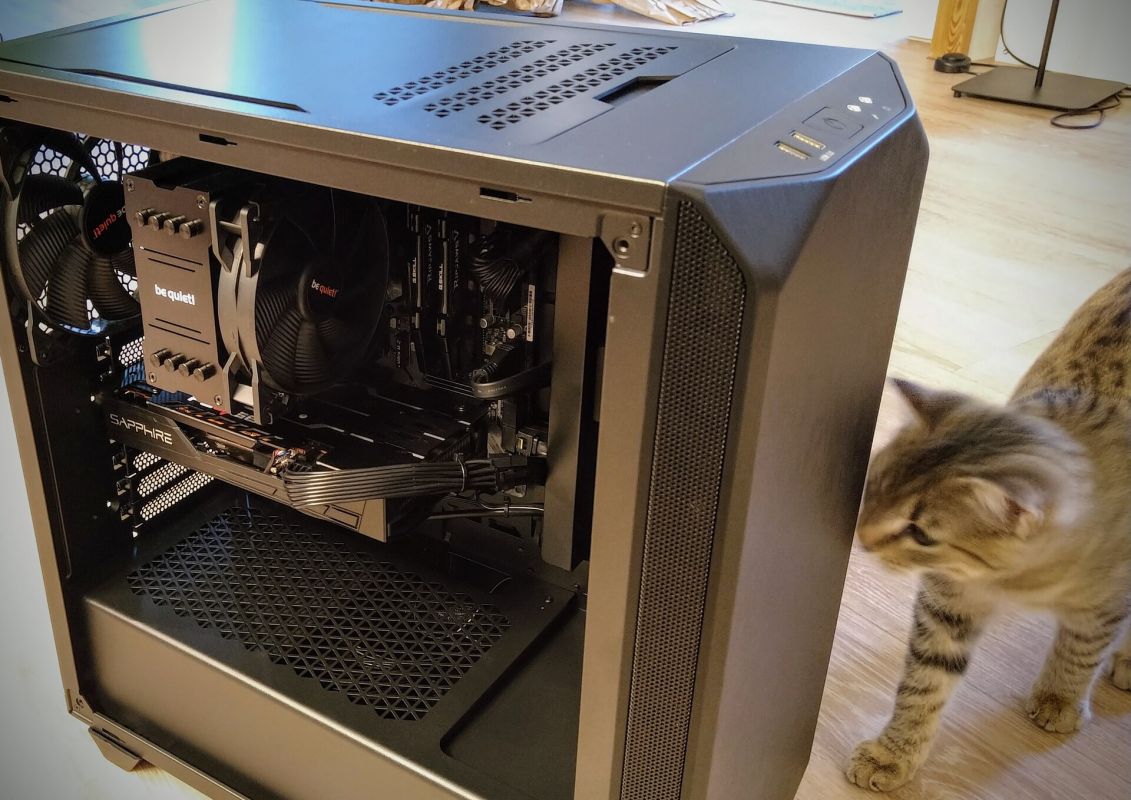
my young kitten curious about the PC
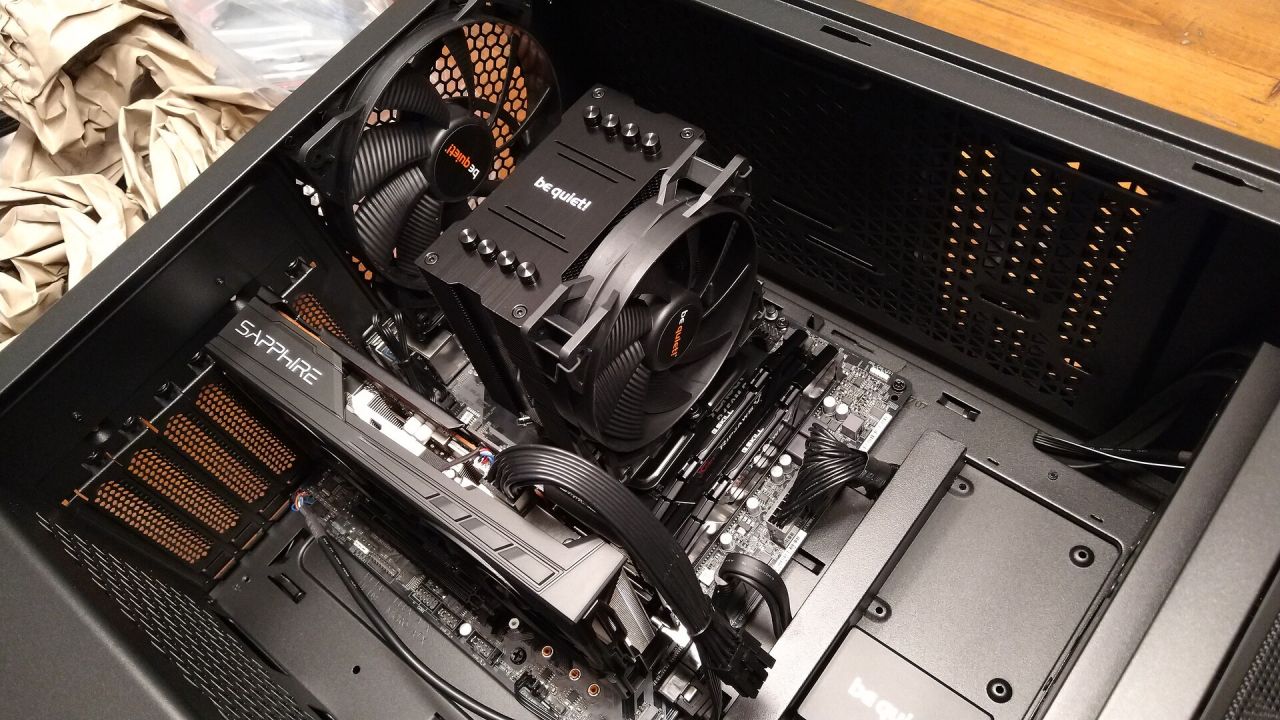
an overview of the motherboard with the components
I'm really happy by the quality of the build made by LDLC team: all done very cleanly with perfect cable management.
I was happy I took this option, because I only had to take my screwdriver for mounting my two SSD. The case had two very cool slot for the drive, positioned into symmetry. With the all black rendering inside the computer; it looks so good!
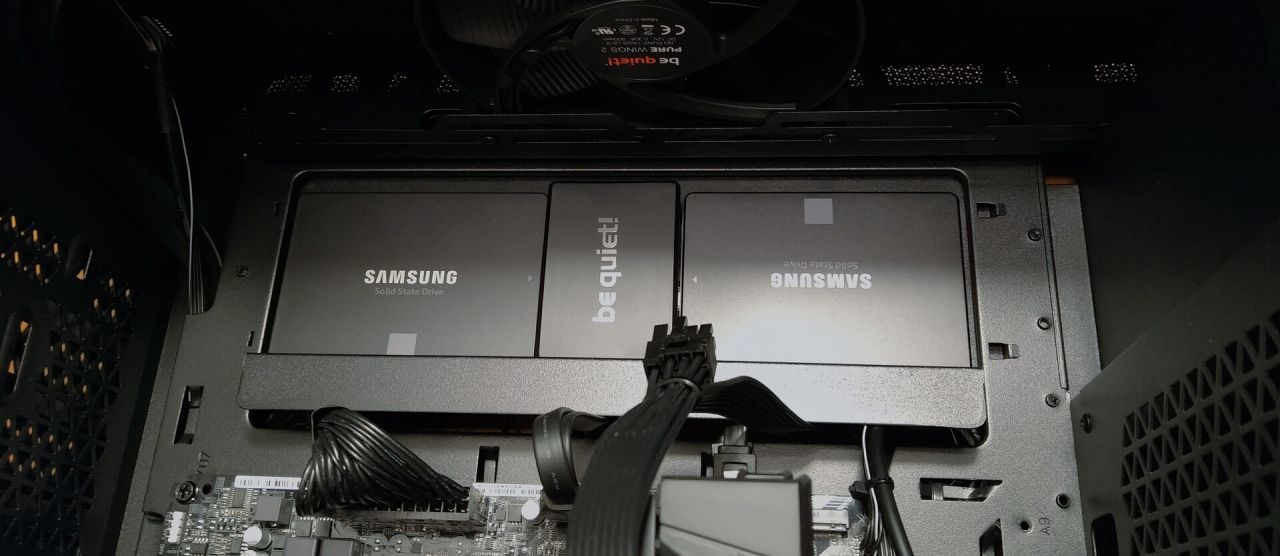
good design for the SSD inside this case
Once mounted, the first run was so silent that I thought the PC wasn't running. That's probably because I was used of the sound of airplane from my previous PC.
After a brief control on the UEFI (good graphic user interface Asrock), I connected a pen drive USB with a Kubuntu 20.04 GNU/Linux system. That's the system I documented in my series Linux for a digital-painting workstation. All was directly working out-of-the-box perfectly from the live session: video, dual monitor, graphic tablet, audio. Happiness!
AMD GPU: the myth of being "easy and open-source"?
Ten years ago, AMD GPU cards for a GNU/Linux system was the worst option you could take for graphism because of bad drivers. But over the last years, many rumors spread about how easy, open-source and great the new generation was. Well, I had a very confusing experience so far on how to setup it correctly!
The documentation is not really easy to follow. I quickly saw that the discrete GPU card require an additional installation to work with Blender. I then went to the official Blender documentation and they advice the ROCm driver while Arch Wiki advice the ProRender plugin. The ProRender pluging being only for Blender 2.8x; I decided a bit blindly to install the ROCm. Installing ROCm is far more complex than installing Nvidia proprietary driver (not packaged by the distro?) and require more than 6 command lines, three reboots and require to stick to a set of distro (Ubuntu LTS is fortunately part of them). Not a big problem to me, but it worth being mentioned as it contrast a lot, imo, with the 'easy' reputation it has.
After I finished the install and switched the Kwin compositor to use OpenGL 3.1: my glitches were gone and I could play with Blender 2.90.1. I can access rendering with OpenCL on the benchmark but I can't use Cycle with the GPU (all models remain gray). On other things I noticed related to the GPU: VLC crashes , glconv_vaapi_x11 gl error, because of a known bug in Mesa. I saw it was open since a year and Mesa had over 2500 open bugs... So, I switched to use Celluloid video player, too bad; I had my habits with VLC... Another small glitch: the tablet configurator of Plasma can't remember the monitor where the tablet was mapped after sleep or lock (no problem with old Nvidia); I'll have to report that and workaround in the meantime using bash script and command-line xsetwacom for now...
So all in all, this first 48h with the "Sapphire Radeon RX 5500 XT 8GB" I can tell the user experience is not as promising as it was meant to be but not dramatic or bad either. In the end, I have good behavior in all my 2D software with OpenGL canvas acceleration and I can continue to do my mockup with Blender Eevee. That's ok for my needs.
If you have more information about AMD GPU config and recommendation to get the best out of it, please share in the comments.
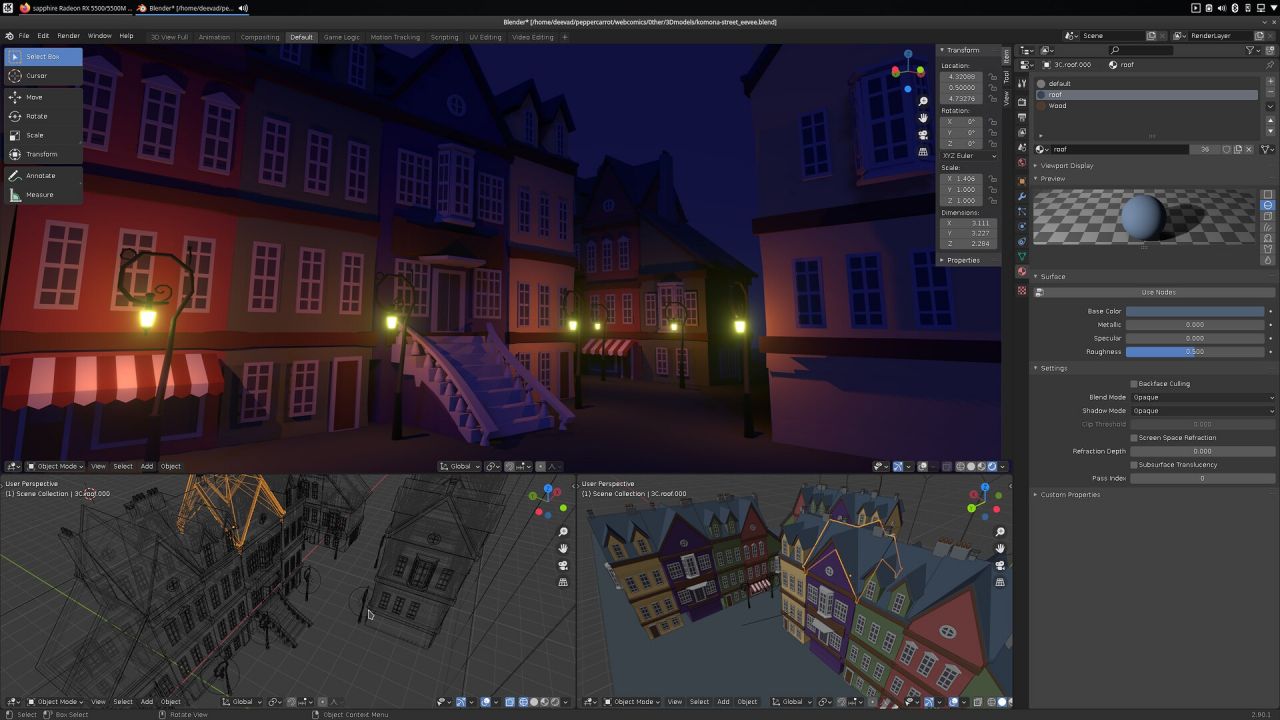
Screenshot, Blender: I use 3D to sketch background in my webcomic; I paint-over them later with Krita
Performances
In overall, it's really better than what I expected and I tried to list here the change I could notice:

AMD Ryzen 7 3700x in action: 8 core, 16 threads, silent
Krita
It really improved everything!
- Complex and large brushes runs smoothly on 4K documents (without Instant Preview).
- I can screen-record and paint at same time without feeling a performance slowdown.
- No glitch or micro lag with Instant Preview, I might start to use it.
- Instant refresh on color adjustement filters (eg. while moving sliders on HSV filters) No time to notice tiling.
- I can paint under 3 filter layers (Color Balance+Color Curves+Sharpen) without any slowdown.
- No more slowdown with ColorSmudge brush engine.
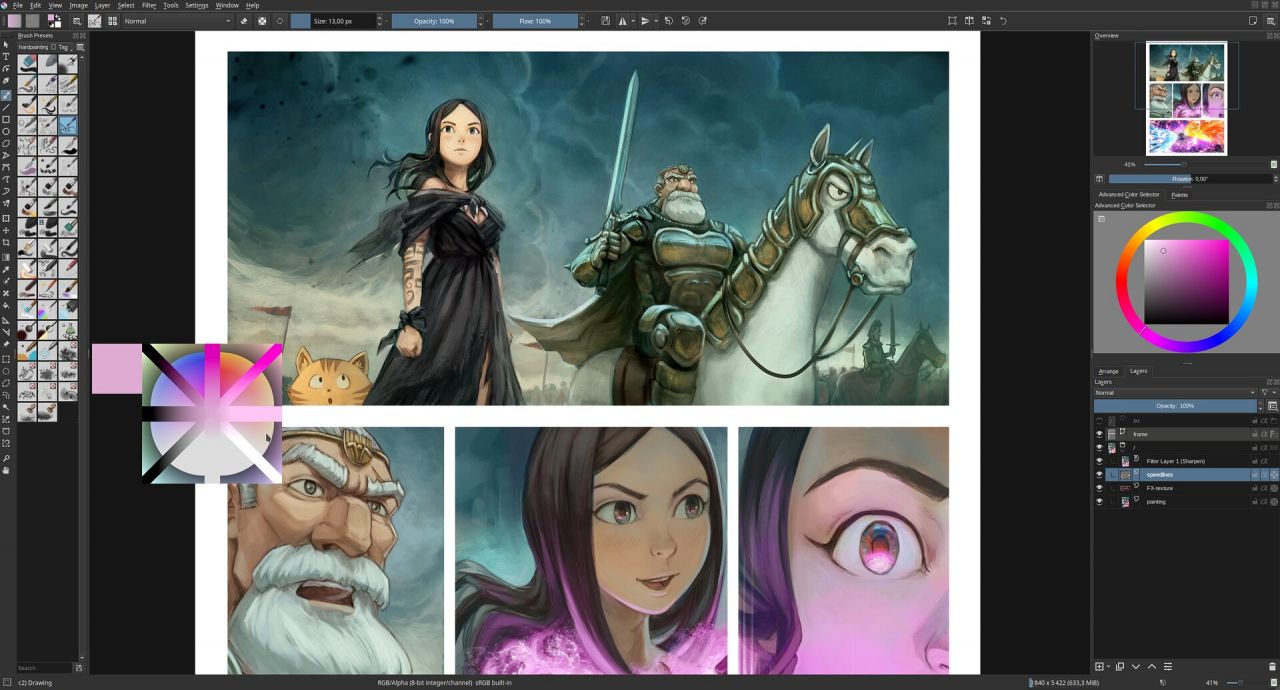
Krita screenshot with a page of my webcomic
- GMIC filters (multi-threaded) now renders very fast.
- Duplicate layers, merging layers, undo happens instantly.
- Transform (Ctrl+T) are super fast to bake.
- Liquify deformation is much improved, not smooth over a square of 2K by 2K but on selection way smoother and interactive.
- Multibrush (mandala mode :P) has no slow-down.
accelerated x6 video: painting with multibrush, under three filter layers (color-balance, invert, edges detection) on a 4K document. Not specially smooth but no issues. Impressive!
On the downside, start-up time wasn't improved so much and colorize-mask refresh too... I also might become a useless beta-tester for performances because I'll have hard time to feel issues that adds a bit of slowdown (on my previous PC, I was very sensitive to this type of changes).
Inkscape
Just the SVG rendering on canvas feels smoother, but this is huge.
Pepper&Carrot renderfarm
Rendering from scratch episode 7 "The wish" (1679 files to render, 43 langs, parrallal process: Inkscape CLI rendering, and Imagemagick rendering).
Previous PC, Intel Core i7-870: 23m28s
New PC, AMD Ryzen 7 3700X: 3m55s
Blender Benchmark
CPU BMW scene, 3D rendering (less is better):
Previous PC, Intel Core i7-870: 27m41s
New PC, AMD Ryzen 7 3700X: 2m38s
GPU BMW scene, 3D rendering (less is better):
Previous PC, Nvidia GTX 650Ti(CUDA): 9min35s
New PC, Sapphire Radeon RX 5500 XT 8GB(OpenCL): 2m47s
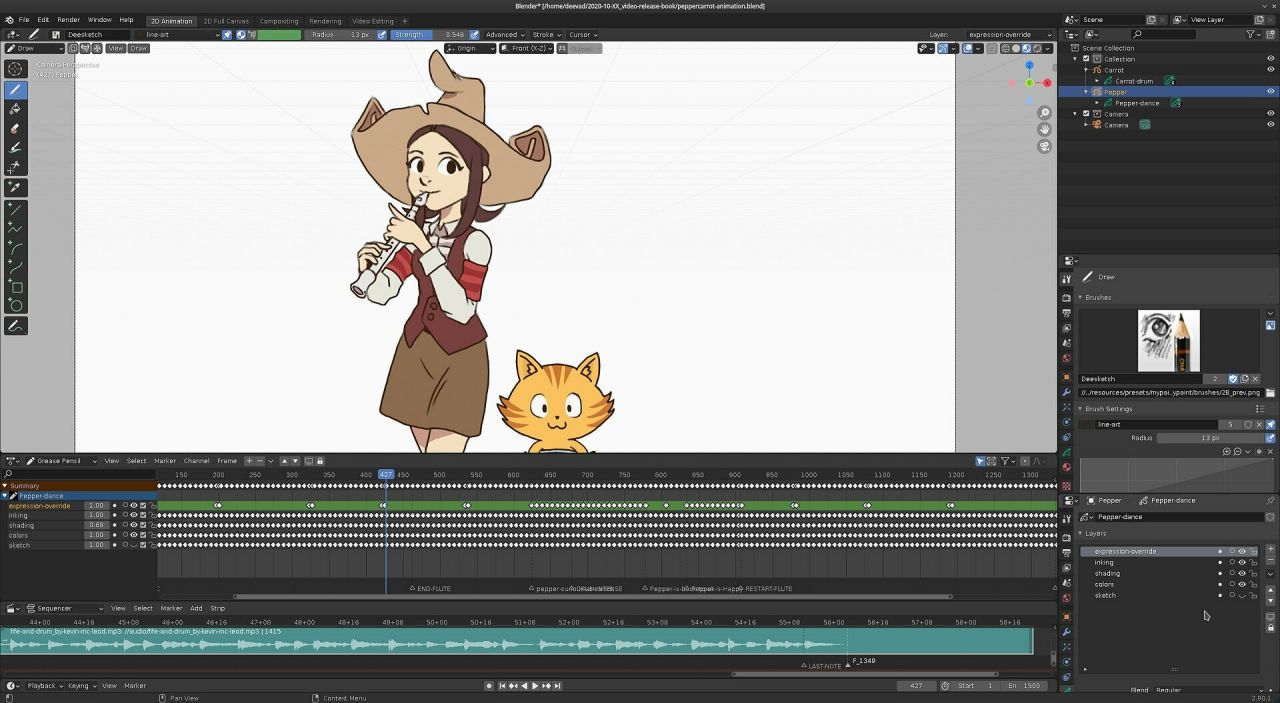
Blender screenshot: a recent grease-pencil animation I made
On the downside:
- Drawing on canvas with GreasePencil is still not smooth for me; especially on scene with many objects/frames.
- No big gain about Blender video sequence editor, playback is still slow and the frame by frame rendering too.
Scribus
- Scrolling books with many hi-res pictures and loading the file is faster.
- Export to PDF is faster too (I forgot to save a render time on my previous PC).
Kdenlive
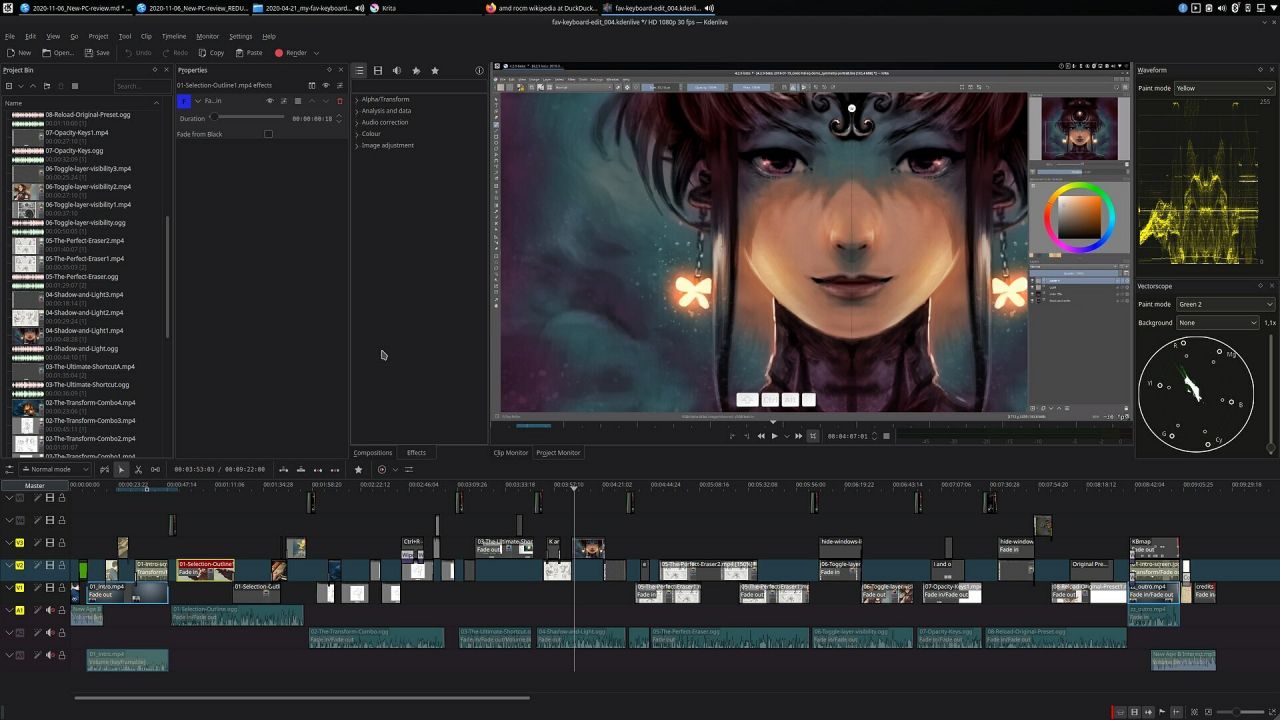
Kdenlive screenshot: while video editing one of my tutorials
A big surprise; playback of my video editing is now WYSIWYG. 30fps for the most part and transitions/effects fall to 18fps but totally acceptable while editing.
Rendering also improved a lot, eg. my 42min long video tutorial about Color Adjustement (1080p@30fps):
Previous PC: 56m41s
New PC: 06m39s
Other
- Plasma: fading animation, windows movements and desktop effect are very smooth.
- Dolphin file explorer: folders with 3000 picture scrolls and render large thumbnail on the fly.
- Nomacs image browser displays large pictures at the speed of light!
Conclusion
I only painted 7h with this PC, made a bit of video editing, recorded a bit; but this is already beyond what I expected for the task this PC is meant to do. I hope it will have a long life!
The Pros:
- Good CPU (performances).
- Silent and beautiful PC case.
- Relatively cheap combination of hardware.
- Compatible out of the box.
- Krita, Inkscape and Kdenlive performances
The Cons:
- the AMD GPU easy open-source myth
- Power button on the case
I hope this review/overview will help you if you have the same type of problem I had for picking a PC!

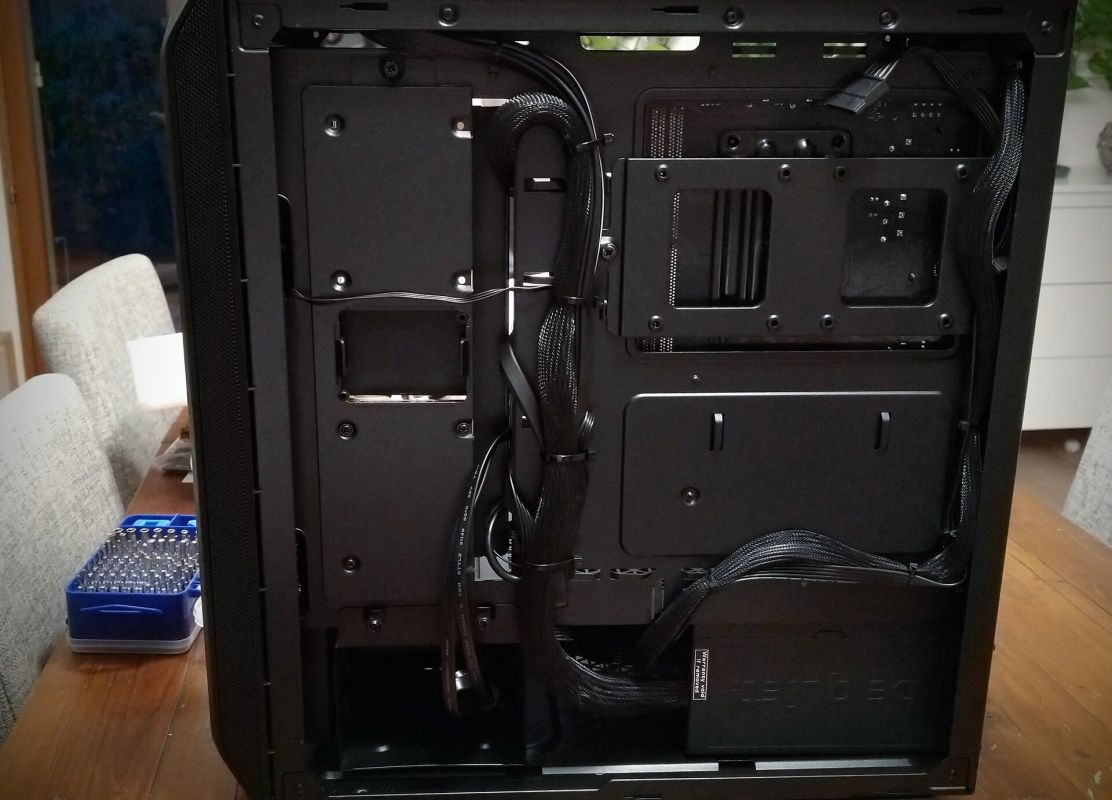
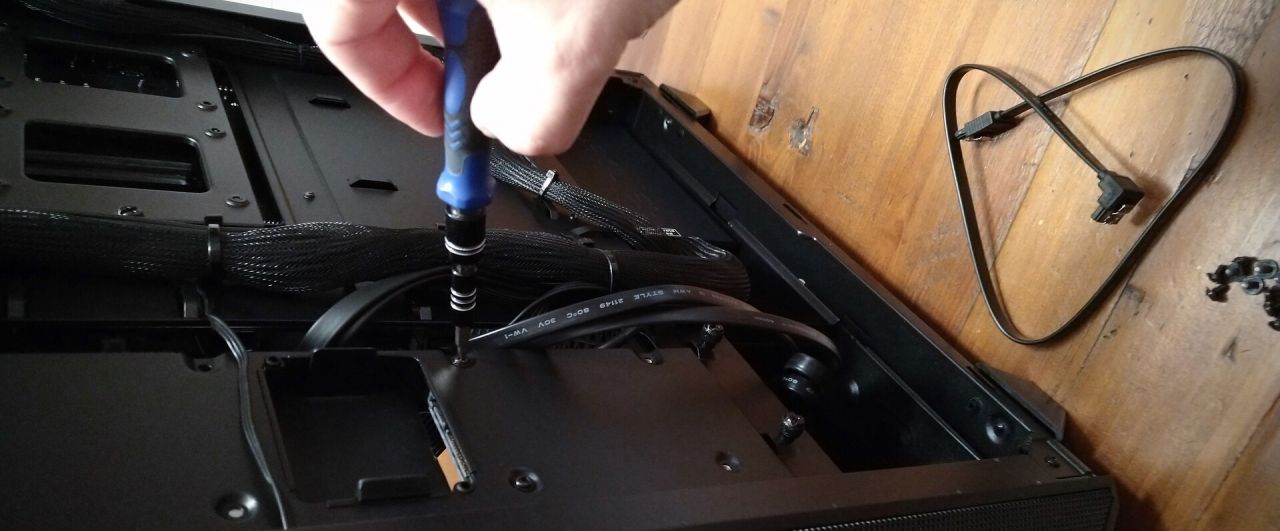
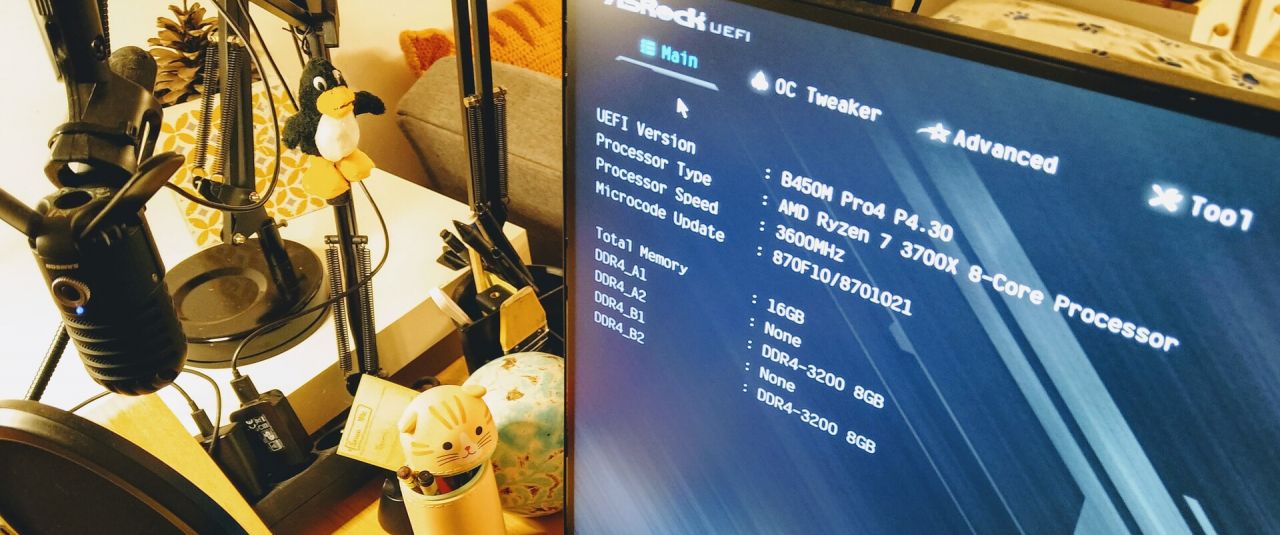
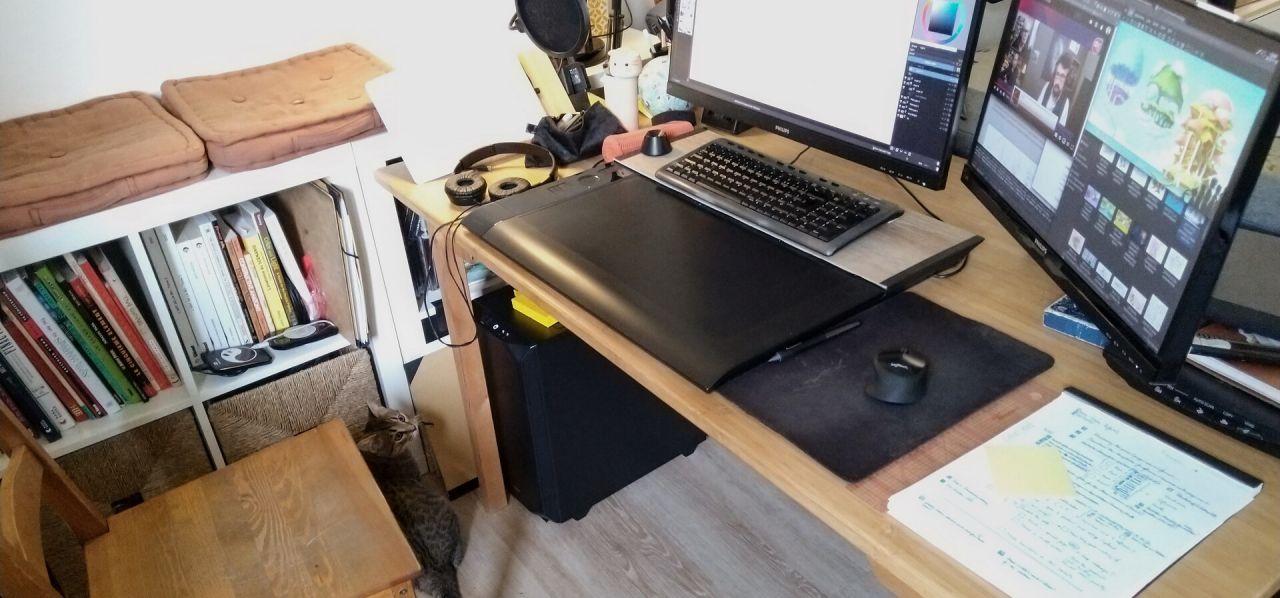
67 comments
Hello David, always fascinating reading about your experience with FLOSS and art creation.
Concerning ROCm, there is a repository (which I'm using):
deb [arch=amd64] http://repo.radeon.com/rocm/apt/debian/ xenial main
Despite the distro name, the packages are actually for Focal Fossa according to https://github.com/RadeonOpenCompute/ROCm/issues/1074 (I'm using it on Debian, so I'm not appraised about its support in Ubuntu). This might simplify the installation of the package next time (if there ever is going to be one ;-)) even if it won't fix the VAAPI issue in Mesa 8-)
Thank you for documenting and noting down the benchmarks for old and new system. It helps a lot. Also good to know about hidden quirks about amd card.
Thanks for sharing your experience. It inspired me to try Kubuntu on my ryzen workstation also. Iam only worried that may my M-Disc Bluray Burner does not work to archive photos. Do you handle some kind of "unchangeable" backups under Linux?
Oh, thank you. It might really ease this install process 👍
I studied the solution of burning blue-rays for doing long term archive/backup but never bought the hardware to do it. It sounds like one of the best long term solution if it is still easy in 15 years from now to read bluray.
Here, I'm still archiving on 2''5 USB disk; duplicated and I try to power them up every 6 month to renew the magnetic health. Every 5 years I also migrate them to new disk (often, because the first 80GB one became easy to store on the next 240GB one, then on the 500GB, then on the 2TB...). Right now all my archive fit 2 mirrors of 2TB.
Maybe you can test your blue-ray burner on a live-install session (from a pen-drive). I haven't burn any DVD or disc since a long time, but I liked Brasero and K3b. Not sure if Blue-ray use something different.
Wow, la config :D.
Une belle bête ;).
Tu as pensé à overclocker le processeur ?
Thanks for your explanation David. I will take a try with the live CD. Mirroring on different hard disks is a good solution. I do it the same for most things, because archiving on Hard Disks are still expensive (about 15€ per 100 GB, with a safety copy 30€per 100 Gb) so I mostly use this only for family photos. I hope to get it run on Kubuntu, Asus offers (of course) no driver.
Hello :) Merci!
Alors la dernière fois que je me suis intéressé à l'overclocking; c'était il y a vingt ans et c'était synonyme de démarrer son PC avec un mini extincteur à côté "au cas ou..." xD
J'ai cru voir dans certain show sur les PC gamer que la discipline c'était un peu banalisé. Je regarderai si je peux tricher quelques Mhz ;-) Merci de m'y faire penser.
Bonjour David,
J'ai peu ou prou la même config que toi (R5 2600 à la place). Et moi aussi j'ai un peu galéré avec mes pilotes AMD pour ma RX5500. Mon utilisation est un peu plus mixte que la tienne : jeux et applications graphiques.
Du coup, une solution que j'ai essayé a été celle d'installer les pilotes AMD GPU Pro, sauf que cela n'est pas possible avec ma distribution (PopOS 20.10), le noyau n'est pas supporté : https://write.tedomum.net/nasra/amd-et-linux-part-4
Il existe une solution : n'installer que le pilote OpenCL nécessaire sans le module noyau, c'est la seule solution que j'ai trouvé : https://write.tedomum.net/nasra/opencl-lacceleration-pour-les-rendus-3d-et-video-notamment
Tout vient à cause de Mesa qui ne supporte que l'OpenCL 1.1 alors que toutes les applications professionnelles utilisent à minima l'OpenCL 1.2.
Mais, à la fin de l'année, tout cela risque d'aller mieux ! L'OpenCL 3.0 est en route et une intégration directement dans les pilotes Mesa est prévue : https://www.phoronix.com/scan.php?page=news_item&px=OpenCL-3.0-Prep-In-Clover
Bref, en ce moment, je suis sur un ppa pour les pilotes Mesa, car cela résoud pas mal de soucis et de performances (dans les jeux) notamment sur les Radeon à base de Navi + l'OpenCL activé pour les applications qui le demandent (GIMP, Blender, LibreOffice aussi... bientôt KDEnlive). Bon, par contre c'est une impasse totale pour DaVinciResolve.
J'ai essayé les pilotes ROCm, avec un échec patent et un blacklist de mon pilote libre dans mes paramètres (j'ai mis du temps à le comprendre). Du coup retour à Mesa de base et ce n'est pas pour me déplaire : tout fonctionne très bien !
Thanks for sharing this info, rely helpful, since I was a bit concern about whether to go for a 6 core or 8 cores since Photoshop shows almost no gains after 4 cores.
By the way, I seems like the Gpu did not have any major advantages since the Cpu is already so powerful. Krita in my experience is CPU bound and Gpu is useful in things like blender but the Cpu is doing a better job then the Gpu. Am I missing something?
ROCm does not officially support RDNA GPUs
https://github.com/RadeonOpenCompute/ROCm/issues/1180#issuecomment-718499682
To get OpenCL support, you have to use the opencl components from the closed source AMDGPU-PRO driver
https://math.dartmouth.edu/~sarunas/amdgpu.html
https://blenderartists.org/t/how-do-i-use-opencl-with-an-rx-5700-xt-on-archlinux/1234545
Hi David.
On the Krita forum we have discussion about Intel vs Amd (https://krita-artists.org/t/processor-intel-vs-amd-raw-power-x-more-cores/8264/8), and we really curious about capabilities of Ryzen processors. DKazakov already tested 2700X.
Could you run you CPU through "FreehandStrokeBenchmark" and put you results there, please?
Here the link on the Lynx3d post he explains where to find the benchmark https://krita-artists.org/t/processor-intel-vs-amd-raw-power-x-more-cores/8264/8
You can keep on using VLC, just disable hardware-accelerated decoding in the preferences.
Just checking on you. Hope you are doing well. in the past almost 3 years that we have had a chat, may be once or twice it took you longer then a day to rely to any questions, and even then it was only by a day or two.
Hey! I'm just experiencing a bit of slowdown :) Thank you for taking care.
Ha, I found it and it works, thanks!
Not easy with all the option of VLC. It's here:
Tools → Preferences , and in the panel tab 'Input/Codec' and at Hardware-accelerated decoding turn to Disabled.
Done! Thanks for the link :)
Thank you
The GPU still has a big role on Digital painting: managing the 2D compositing of the desktop environment, the FPS of the canvas, the movement of the cursor, the rendering at rotation/zoom of the canvas and doing all of that while sometime other portion of a dual monitor are updated (like playing a video in a corner). I saw many setup with a good CPU getting poor performance on Krita because of a Intel integrated GPU (the case of many laptops).
So far after a little week, the setup is stable :)
:-) Yes, if I open the system monitor while painting, Krita use a bit of all core while painting. I also took time last days to test workflow I couldn't use before because of performances (not an issue anymore). In final; I finished my evaluation and exploration not really adopting anything new but that was fun to go back experimental.
Bonjour Nasra,
Bonne nouvelle pour l'OpenCL 3.0! et merci encore pour le partage de tous les liens sourcés. Très intéressant à lire tout ça et du coup j'y vois bien plus claire.
Its ok to take a break every now and then and even a vacation while once in a while.
I left the industry and became an accountant because of work stress. People used to think that we charge them for just drawing a few lines and don't know that we have to think about every thing from the physiological effect of colors and spears to local culture of individual towns of our client.
Sorry for the lecture, I know you already knew this and have your reasons, but take care,Taking a break always boosts my productivity.Just remember to draw some Doodle of pepper and carrot with local tourist attractions on your next vacation.
:-) Thanks!
Hey there, long time P&C reader and also long time Linux user here. I applaud your patience for continuing on the FOSS path! I wrote a little piece that probably won't help much, but I also have a tip that could potentially improve your situation.
As a user of Intel iGPUs and AMD dGPUs, I can tell you that the open source AMDGPU "myth" is no myth, but true (if we can agree that all software has issues sometimes). There are two exceptions to the rule, which you both completely match, unfortunately:
1) AMD's _graphics_ drivers in Mesa are very good. I've never had to lift a finger, everything came with the distro installation already and worked out of the box. However, that can't be said about _compute_ drivers. No company cared about compute in Mesa for years and thus it didn't get anywhere. This autumn the situation started to improve and reportedly AMD users can even run Folding@Home on Mesa now! I suppose using Mesa (well, Clover) for OpenCL compute is the eventual goal, while any additional external installable drivers will remain as certified solution for workstations or as an optional improvement if Mesa isn't comparably good (for OpenGL and Vulkan it already has been for a long time). I understand you need compute for your work right now, then it's either PPAs/custom repos or a lot of fiddling.
2) For newest AMD GPUs to work perfectly, you benefit from newest Mesa and newest kernel versions (AMDGPU kernel driver is, well, in-kernel, while Mesa contains the userspace part). That's in direct contradiction with using Ubuntu LTS, which doesn't care for latest versions and aims at stabilising the older versions instead. Theoretically, there might well be an improved Mesa version available that Ubuntu just doesn't use yet.
The tip: there's a PPA by Oibaf ppa:oibaf/graphics-drivers that contains the latest Mesa. Maybe it will help with some of the issues?
Bonus: as I've said, all drivers have issues sometimes - Nvidia drivers don't work on Linux 5.9 at all even though it was released a month ago. No driver is perfect, but some you can try to compile with a patch :-)
Sorry for the wall of text! I hope that it explains some of the things or even helps.
Don't be sorry for the wall of text and thank you for taking the time to explain it.
Very good point for the PPA and Mesa and the Ubuntu LTS situation; I'll probably try (I'm just a tiny bit reluctant because I have now everything working correctly; except probably Blender Cycle rendering preview but I can live with it as I'm moving to use Eevee mainly for my mockup.
Did any of your Krita setting change along with the Hardware Update?
Yes, and not only Krita but Kdenlive, Scribus, Blender, and all the software on my desktop.
It's because of how my system is setup, I have all my preferences saved on dot files in my /home partition.
Reinstalling the system at root doesn't loose any of my preference settings.
If you are on Windows or MacOS and are affraid to loose your settings after changing computer. You can open the location of where your preference are stored within Krita in this menu:
Settings → Manage Resources , and look for the button Open Resource Folder.
Then you can copy and save this file, and note the path. That's exactly where your future Krita will try to recover your settings.
I'm not asking if your settings changed automatically, I'm curious what you had to chang to optimize Krita after the hardware update. Especially, did you disabled AVX vector optimization option and felt any difference?
Ah, my bad. I kept exactly the same setting I had in the performance panel.
Memory limit: 85% (13GB)
Swap Undo after 50% (6GB)
Swap size: 24GB, location /tmp/
CPU limit: 16
Mx FPS while painting: 100fps
No, I haven't disabled the vector optimisations for AMD CPUs, you can check my CPU benchmark on the that I9S share above (on Krita-Artist forum).
Hello David.
I use very similar configuration (Ryzen 7 3700X and RX 5700 XT). For me on the MESA drivers and ROCm works guide in link below. There is the same repo source as Oblomov mention and entire step by step guide.
url: https://rocmdocs.amd.com/en/latest/Installation_Guide/Installation-Guide.html#ubuntu
Hi T.Lama; yes, that's what I ended using. Thank you.
This is the one I describe in the article with three reboot and command lines.
Just to complete if a windows user take look: The kritarc on windows is in the path %LOCALAPPDATA% (C:\Users\<username>\AppData\Local).
I am looking for a tablet graphic for my daughter, 14 years old, not too expanse but good rapport price/quality. She is drawing manga and doing well. She wants a tablet for Christmas. All our pc are in ubuntu, my husband is in software engineer and a geek as well. Thank you in advance for your advice. Nathalie ( sorry for my english i am french :=)
Hey Nathalie, no problem, I'm French too. Then let's continue in French.
C'est compliqué et je propose deux solutions:
1) Le meilleur prix et compatibilité va sans doute se trouver chez Huion dans la liste de tablette prise en charge par le driver libre Digimend qui s'installe avec un simple *.deb: https://digimend.github.io/tablets/ .
Il faut trouver une surface pas trop petite (pas de A6 et minimum un A5). Ici, j'ai ce modèle: https://www.davidrevoy.com/article331/setup-huion-giano-wh1409-tablet-on-linux-mint-18-1-ubuntu-16-04 , et il fonctionne mais demande de la bidouille (script pour les bouttons, installation du module Digimend) et c'est pas mon matériel préféré (pression du stylet un peu "patatte/cheap"; ça s'écrase assez vite). Les autres marques comme Gaomon/Xp-Pen etc... risque d'être dans le même créneaux: bidouille, pas cher et matos un peu cheap niveau experience et qualité.
2) Avec un budget un peu plus conséquent, mais souvent à mon avis justifié; il y a les Wacom. Une A5 c'est très bien pour commencé (et on en trouve pas mal d'occasion à prix plus petit).
Ubuntu avec GNOME comme bureau (par défaut) normalement à un panneau de configuration qui permets d'acceder à toutes leur options principales. C'est l'avantage de Wacom: mieux pris en charge et quand même un savoir faire au niveau qualité de dessin/pression toujours assez bien pensé. Ensuite, si elle aime le Manga; elle va vouloir faire des lignes fines; et sur une petite tablette dissocier de l'écran, ça peut-être frustrant. Si le budget le permet; une petite Cintiq (Cintiq 13 ou 16) pourrai lui rendre un gros service et boost pour sa passion.
Voilà, j'ai écris sur mes tablettes dans ma carrière ici: https://www.davidrevoy.com/article332/tablet-history-log
Bonne étude!
Merci pour votre longue réponse. Mon mari vous recontactera sans doute pour des conseils . Votre portfolio est superbe et quel talent. Je le ferai voir a ma fille, cela lui donnera des idées. Belle journée. Nathalie
I use the OpenCL driver from amdgpu-pro not rocm as rocm does not officially support navi gpus and it works for my on my arch based systems.
Video about SSD life time and how choose drive size:
https://www.youtube.com/watch?v=-XZNr7mS0iw
It might be a bit offtopic but I'd like to ask you a few questions if you don't mind.
• I often see people recommending using color dodge in digital art. Is there any blending mode in Krita that gives similiar effects? I've seen the dodge brush but it looks a bit... dodgy to me.
• Are the fonts we can select in Krita free to use in artwork I want to sell or do they have different licenses I have to check for every single one of them before using?
• Is the money we can get from patrons on Patreon taxed? Do I need to have a registered enterprise to use it?
Hey! Big questions here, and hard for me to dive into them quickly, but I'll try:
* Dodge:
You'll find more info on my video about blending modes. If the effect is too strong; try to select a dark color (10% value) and very saturated if you want cool corona light effect. Note also Krita has two blending mode better imo than Color Dodge: Addition and the excellent recent Luminosity/Shine (SAI) that probably deserve a future video for it alone :)
* Font/License:
The license who appears on Krita are just the one installed on your operating system. Using them in commercial artworks might get you in trouble if you don't know their licenses. Proprietary font creators often hunts for non authorised commercial usage of their fonts. On Pepper&Carrot and my blog (and for my client) I work with only fonts with this licenses: SIL, Public Domain, CC-By, GPL.
* Money/Tax/Patreon:
Yes, creators needs to pay taxes on the money they receive from Patreon (and Patreon takes a percent; + the transfert of money cost a bit). This taxes depends of your country. You need to acquire a legal status to declare money earned this way. Here I have a 1 salary entreprise; a sort of special status named micro-entreprise (a French thing, not sure it exists on other country).
Thank you very much for replying.
Bonsoir David,
Merci pour cet article qui m’a particulièrement intéressé, étant un peu dans la même situation !
Je travaille avec un vieux Mac Pro (2010) passé sous Manjaro depuis plus d’un an (switch sous Linux sans retour en arrière possible).
Le travail de retouche photos avec Art (fork de Rawtherapee) reste faisable, le dessin sous Krita aussi, bien que les ralentissements sont notables dès lors que les calques s’accumulent, mais le travail sous Blender devient rapidement impossible par manque de puissance (en 3D mais aussi en 2D avec le grease pencil)
J’attends de recevoir ma nouvelle config à base d’AMD (Ryzen 7 3800X et radeon 5700XT avec 32go de ram) en espérant que lu compatibilité Linux Manjaro soit au rdv sans trop mettre les mains dans le camboui !!
Une chose m’intrigue dans ta capture d’écran de Blender… La Brush utilisée est une brush de ta fabrication ? ou est ce une Brush trouvable sur le net (et achetable ?)
Je rêve de pouvoir utiliser les Brush de Krita (qui sont vraiment extraordinaires. celles de ta fabrication notamment) sous Blender en vectoriel… Si tu as des tuyaux. des conseils pour créer des Brush sous Blender, j’en serais ravi !!
Merci encore pour ton travail extraordinaire, et l’esprit "Open Source Éthique" de ta production.
Bonjour Jllailes,
Je ne conaissais pas Art (fork de Rawtherapee), c'est très intéressant. J'imagine avec ce CPU et cette carte ça devrait fonctionner au poil :)
Alors pour Grease Pencil et la capture d'écran, c'est bien une brosse perso; mais en fait Grease Pencil est hyper limité à mon gout de ce côté là.
Donc je n'ais pas encore vraiment de brush-kit; juste deux ou trois pinceaux pour faire du sketch, de l'encrage et du remplissage.
Ils sont simplement tous des fork des kit de Pepeland (distribué sur Blender Cloud et via sa chaine Youtube).
Mes brosses n'ont que deux personnalisation: La courbe de pression et la vignette pour les différencier dans ma liste de preset. Ca serait mal-honnête de partager cela ^__^
Donc autant prendre les deux kit de brosses de Pepeland, ils sont parfait et les ajuster un peu en local pour compenser les différences de tablette et de ressort de pression dans des stylets plus ou moins fatigué.
Merci encore pour les mots sympas et bon courage pour la config! J'en veux bien prendre quelques nouvelles ;) je suis jaloux des 32GB!
Bonsoir David,
merci pour ta réponse.
Oui j’ai également les Brosses distribuées par Peperland, qui améliore grandement le Grease Pencil en effet. C’est une fonctionnalité de Blender encore jeune certes, mais je pense à très haut potentiel pour l’animation 2D bénéficiant de l’espace 3D.
Il est clair que pour l’illustration, on est encore à des années lumières de Krita !! Mais les deux softs se complètent bien je trouve.
Comme tu le conseilles, je testerais de modifier les brosses existantes…
sinon ordi reçu !!!
2 trèèès grosse soirées/nuit d’installation de Manjaro, résoudre les problèmes, Maj du Bios, trouver le kernel compatible avec le matériel, reconnaissance de la cintiq etc… récupération de mon Home, récup et branchement de mes anciens SSD…
Bref… Tout fonctionne !!!!
Effectivement je gagne inexorablement de la vitesse dans tous les softs.
Art (qui est vraiment un soft photo extraordinaire, pour moi un concentré du meilleur des softs photo libre, avec un codeur, Alberto Griggio, à l’écoute et très réactif) est devenu ultra rapide. Krita également.
J’ai aussi testé Gimp qui était peu utilisable avec mon Mac/Linux (vraiment lent), et qui est devenu tout à fait véloce !
Blender reste parfois un peu à la traîne sur des .blend assez lourd, mais je dois tester peut être d’autre pilote pour le GPU. (je travaille aussi sur la version alpha qui n’est sûrement pas la plus optimisée !) J’ai tenté d’installer ROCm (il y a un dépot AUR), mais sur Manjaro, c’est plutôt pas mal bogué… je suis repassé sous OpenclAMD, AMDgpu… Blender reconnait bien ma carte qui peut travailler sous Cycle…
Sinon pour l’instant, les 32 go de Ram jalousée n’ont pas trop chauffées, mais elles me permettent pour l’instant de continuer ma mauvaise manie d’avoir 150 onglets ouvert dans Firefox…!
Dans l’ensemble je suis très satisfait de cette config, et ne regrette pas mon Macpro qui va passer sa retraite comme ordi Linuxien Familial, et centre Multimédia !!!
Bonne nouvelles! Merci pour le partage du retour.
Oui, Grease Pencil à énormement de potentiel. Je vais suivre ça de près de toute façon.
Hi David! I tweeted you when you announced the new system and i was also going to get a similar system and here is my experience.
Got a ryzen 2700x cuz it was significantly cheaper then 3700x. A b450m motherboard same as you and 2x 8gb ddr4 ram. A Corsair combo of cpu case and power supply (i still hate those rbg fan) but this cabinet (carbide) is most professional looking of them all.
But i went with a used rtx 2070 and manjaro booted and worked without a single hitch. I am using shotcut and rendering time has been as phenomenal as you are seeing here compared to my old cpu (i7 3770).
Haven't tested on linux but on windows, rtx has optix is supported in blender and the noise removal is phenomenal. Also nvidia's ooengl performance is great with krita which i suspect would be on poorer side on amd.
So yeah similar results (obviously my cpu is slower) but the gpu experience is vastly different.
Thanks for sharing your infos that has helped me take my decision.
Thank you for sharing your configuration! It's precious on the comments of this article.
When I'm looking at your setup note. It is a gaming one because of the Ryzen 7 and Sapphire Radeon 8GB. That's a perfect for drawing. I don't know if you reply to this but. I only have a regular graphics tablet and cannot afford like Wacom Cintiq and XP Pen. Do it affect my drawing skills?
Thanks!
It really depends many factor for the tablet. I saw artist developping amazing drawing/painting skills with small tablet on laptop screen, sometime way more advanced than other professional with the best Cintiqs and computer monitors. So, it is hard to make any rules here. It really just depends your comfort and your adaptation to the hardware limitation. I started my digital painting carreer on a small cheap Wacom the first years, and it was really ok.
Nice build.
Sadly I'm not having much luck with my AMD RX580 GPU on either Kubuntu 20.04 or Mint 20.1 Cinnamon.. :-/ Perhaps I'll try installing the ROCM drivers as per your guide, as the AMDGPU-PRO opencl drivers arn't that stable...
Lol, I suspect it was a defective GPU, anyway it's now returned for a refund by the retailer. So I'm back using my poverty spec Nvidia GT1030 2gb GPU while I research a replacement (which will be Nvidia!)
Good news though, Kubuntu is nice and stable again :-)
Bonjour!
Je suis en formation dessinateur/illustrateur et je dois bien entendu apprendre à connaître et travailler aussi avec des outils numériques (j'ai déjà investi dans une tablette numérique Huion Inspiroy dial q620M)
Le problème vient de mon ordinateur portable (windows 10, 64bits, Intel Core I5, 7200 UCPU 2.5 gHz, 8 Go de RAM, Intel HD Graphics 620). L'écran est infernal, le rendu dépendant évidemment de son inclinaison.
Or pour moi, ces caractéristiques me semblent insuffisantes. Je ne suis que très peu familier avec l'informatique aussi ma question:
Quelle configuration minimale pour un PC pro pour un dessinateur/illustrateur ? Quel Ecran?
Pour "tenir" au moins qqes années?
Je vous remercie beaucoup pour vos réponses afin de m'orienter dans ce monde qui m'est inconnu.
Très bonne continuation!!
Merci!
Alors j'ai justement publié les specificité de mon PC que j'ai changé dernièrement; c'est Pro et à la fois assez économique pour les performances.
https://www.davidrevoy.com/article806/review-my-new-desktop-computer-for-a-gnu-linux-digital-painting-workstation
Sinon; ne conaissant pas l'utilisation de ressources de Win10 (j'imagine bien au delà de mon Kubuntu Linux) je conseillerai au minimum:
- 4 coeurs avec plus de 3.2Ghz de puissance, le plus au delà de ça, le mieux.
- 16GB de RAM (mais avec un slot de libre pour une mise à jour dans qqs années à 32GB)
- une carte graphique dédié, type 'gamer moyen de gamme'.
Pour l'écran; un qui couvre bien l'espace sRGB au minimum, 1920x1080p en resolution pixel minimum.
En générale; les écrans sont tous assez bons; l'investissement dans une sonde de calibration des couleurs est pour moi un must; sans ça, dur de voir un écran avec un gamma cassé, trop bleu, trop jaune, etc... Un petit redressement d'un oeil numérique externe rends fréquentable même les moins bons écrans que j'ai testé.
Enfin, je dirai pas pas un très grand écran avec cette tablette : la vingtaine de centimètre de large de la Huion Inspiroy dial q620M risque de donner un ressenti "glissant" avec de grands écrans (à cause de l'effet: un petit trait sur la tablette fait un long trait sur l'écran, une sensation de perte de controle dans les détails et de curseur qui tremble...).
Bon courage, (et mon avis est sans doute loin d'être le meilleur; n'hésitez pas à recroiser plusieurs avis.)
Vraiment merci pour toutes ces pistes d'informations. Par ailleurs vos tutos sur Krita vont également beaucoup m'aider. Et bravo pour votre travail, le partage...
Thank you for sharing!
Great to hear that you got all these programs working on Linux. I am currently looking for a Linux solution for using some of the programs you mention in your article (like Krita), but I also plan to use it with ZBrush, Substance Painter and Keyshot, so your article is definitely helpful though I am not sure about which Linux distribution to choose.
Kubuntu has one great disadvantage, which is that it connects to third party services by default, which usually you don't want as a Linux user, as you already have this problem with propietary OSs like Windows and Apple.
Good luck with your installation! Big video editor and sculpting/live 3D painting big proprietary apps sounds difficult to install. They probably need a close access to the hardware; I hope you'll not meet trouble on this part. I had no idea Zbrush had a Linux version. Good to know.
A nice guide, thanks David Revoy!
At the moment I'm researching upgrades for my current system which has an old AMD A8-6600K CPU, 16gb ram, and an Nvidia GTX 1660 GPU.
To upgrade to a modern CPU, will need new motherboard, as well as CPU and Ram. At the moment an AMD Ryzen 7 3700X is what I'm thinking of CPU wise. My uses will be photo editing, and 3d rendering.
Hey, almost one year after, I'm really happy with this CPU. I thought I had an issue with it at a point, but it was the motherbard. This is probably the part where I regret I haven't invested double price. My cheap motherboard does the work, but it feels like the support on it of this newer CPU was a bit of an impro/tweak. The Bios is a bit sketchy with many adjustements, a Bios update fixed many of my issues... My GPU had a non complete support when I bought, but now , each update brings better experiences. The case and alimentation I selected are both excellent. All in all, if I had to redo this config, i would invest into a better motherboard. Maybe one with more USB3 output too, its crazy how they tend to miss after scanner+mic+cam+external disk+tablet+mouse+keyboard+etc...
That's great to hear you are happy with the CPU. Currently I'm pricing up my upgrade bundle (Motherboard, CPU, Memory)
While a Ryzen 9 3900X would be pretty impressive with its 12 cores, and 24 threads, it's not giving me much money left in my limited budget for a decent amount of memory and a decent motherboard. But I do think the Ryzen 7 3700X will be a good upgrade from my current system which has an AMD A8 6600K Quad core cpu.
New hardware bought, and on it's way
AMD Ryzen 7 3700X Eight Core 4.4GHz
Patriot Viper Steel 32GB (2x16GB) DDR4 PC4-25600C16 3200MHz Dual Channel Kit
Arctic Freezer 34 eSports Duo Black/White CPU Cooler - 2 x 120mm
Arctic Silver 5 Thermal Compound
Seagate 2TB Barracuda HDD 7200RPM 256MB Cache Internal Hard Drive (to replace my current 1TB /home partition drive
MSI B550M PRO-VDH WiFi (AMD AM4) B550 Micro-ATX Motherboard
I could have saved around £50 by going for a cheaper motherboard, but the one I went for should be good for future upgrades as well as supporting WiFi!
Although I'm not sure Ubuntu 20.04 LTS based distros (like Kubuntu / Linux Mint) will fully support the new CPU & motherboard effectively?
Oh wow, cool config! No GPU?
That's a wise choice to get wifi on the motherboard.
True, 20.04LTS receives update but rarely not too big things; like new features of kernel and new display driver. I think I activated a repo (a ppa) to get kernel update on mine; I started to get issue; but it was more with the GPU and AMD driver.
I'm reusing my existing Nvidia GTX 1660 GPU.
I've since also bought a 500gb M2 NVME SSD for the O/S to go on, instead of the current 120gb Sata SSD. I'm probably going to do a complete fresh install of Kubuntu 20.04LTS, as I've been doing a few distro hops recently. So I'll use the new 2TB Hard drive for a new home paritition, copying my old files over once I've got the OS installed. At least this will let me tidy up a lot of old configuration files from previous OS installs.
Probably a job for what's left of the weekend :-)
So, how was this week-end of moving hardware/os ?
nice blog. well done.
Technolom IT Solutions
Alas, not great! A few instabilities, especially getting the Nvidia drivers running, so I hopped back to Linux Mint Cinnamon (tusing the lEDGE Iso which has the more up to date linux kernel). However I am getting annoyed by the little issues that Cinnamon has (e.g. mouse cursor changes size on QT based apps), plus a poor menu editor, that I think I'll do a bit of research with regards to getting Kubuntu working again. Dolphin is a *very* powerful file manager!
Since my main video editor application is Kdenlive, perhaps it makes more sense to use a distro which supports it natively!
Maybe one of these years I'll stop distro hopping, and actually use my machine productively!
However, doing some benchmarks, and my new system is a lot faster than my old one! And the old motherboard, cpu, etc, I transferred into my old old computer, which I use as a HTPC in the lounge. Waste not want not, as the saying goes!
Hi,
are you using "linux-generic-hwe-20.04" ?
https://duckduckgo.com/?q=ubuntu+kernel+hwe
sudo apt install --install-recommends linux-generic-hwe-20.04
Hi Talos,
Yes, I think I activated that kernel not long time ago here; in hope it will solve a little issue I had with a webcam (not sure).
Post a reply
The comments on this article are archived and unfortunately not yet connected to a dedicated post on Mastodon. Feel free to continue the discussion on the social media of your choice. Link to this post:You can also quote my account so I'll get a notification.
(eg. @davidrevoy@framapiaf.org on my Mastodon profile.)